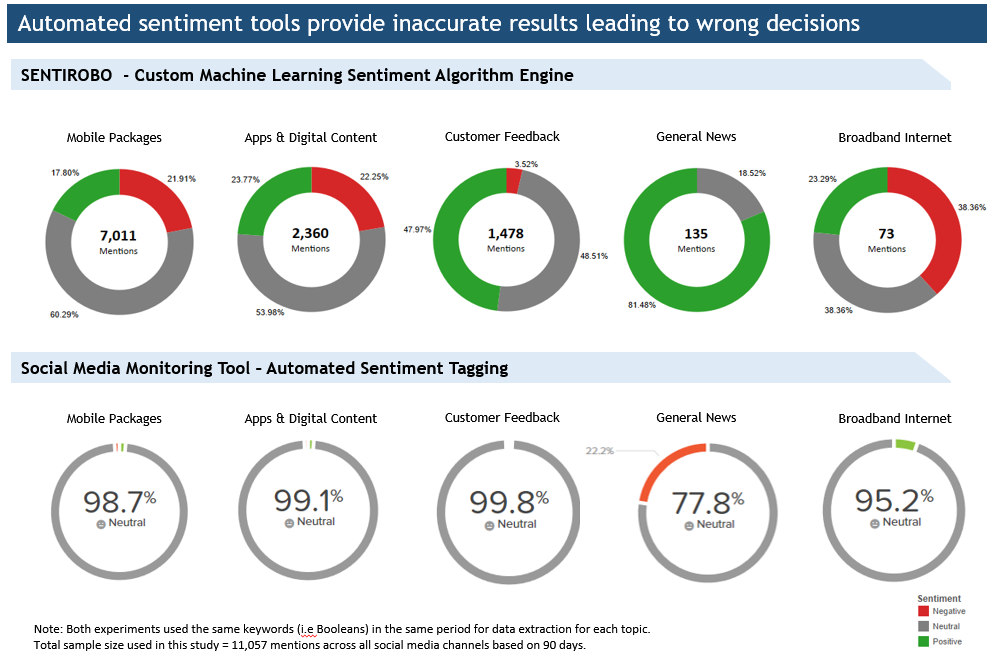
There is a reason why we continue to rely on automated tools (i.e softwares) to monitor social media – it saves us time. With few clicks, a handful of pretty charts are presented to us in a dashboard – inevitably forcing us to believe what is shown to us by the tool.
There are more than 250 companies globally that offer social media monitoring tools which automate our daily tasks.
As the internet and social media users continue to grow exponentially, measuring a brand or consumer sentiment becomes an important element to arrive at the right strategy and decisions for many businesses and organizations.
Obtaining meaningful insights from social data can be a challenging task as automated tools are under immense pressure to measure sentiment accurately. More so when most of the internet users are using their native language to communicate.
75% of the global internet users use their native language.
Statista.com

According to various research studies and recent findings from FreshMinds, a research consultancy in the UK, found that sentiment accuracy from various social media monitoring tools, on average, was between 30-60%.
We are delighted to share with you a comparison analysis between our own custom text algorithm engine, SENTIROBO vs. automated sentiment by a social media tool.
The proprietary text algorithm engine offers data processing of multilingual text data including local dialects with accuracy up to 100%.
“The result from various sentiment analysis on different topics show that one cannot blindly rely on automated tools to process sentiment from social media data; which effectively can lead to wrong strategies, decisions and actions.” says Shahid Shayaa, Managing Director and Founder of Berkshire Media.

The above experiment was done fairly using the following parameters:
| Client Name | A large Telco company |
| Total Sample Size | 11,057 mentions (i.e posts) |
| Data Source | 10 digital media and social media channels |
| Client Industry | Telecommunications & Internet |
| Language | Bahasa and English |
| Number of Topics Analyzed | 5 |
| Name of Topics Analyzed | · Mobile Packages · Apps & Digital Content · Customer Feedback · General News · Broadband Internet |
Using the right approach can bring meaningful and more actionable insights from social media data.
Specialization in Bahasa Melayu (i.e Malay language) over 8 years has positioned Berkshire Media to understand the complexity of the language vis-a-vis local dialects, nuances and non-dictionary based keywords.
A custom-built text algorithm engine known as SENTIROBO is capable to process sentiment and emotions from text-based data with a high degree of accuracy as compared to the traditional Natural Language Processing (NLP) method.
Read more about our sentiment analytic services here.
Note: Bahasa Melayu is a important language of the Austronesian family spoken in Brunei, Indonesia, Malaysia and Singapore. We estimate that the language is used by 290 million people in Malaysia and the eastern coast of Sumatra in Indonesia, and has been established as a native language of parts of western coastal Sarawak and West Kalimantan in Borneo. It is also used as a trading language in the southern Philippines, including the southern parts of the Zamboanga Peninsula, the Sulu Archipelago and the southern predominantly Muslim-inhabited regions in Thailand.

About the Author
Shahid Shayaa is the founder and managing director of Berkshire Media. He is on a mission to drive data-driven insights and communication strategies for companies. Specializing in machine learning text algorithms, he publishes various scientific papers on social media analytics to better understand consumer sentiment, emotions and behaviour for marketers and campaign managers.




